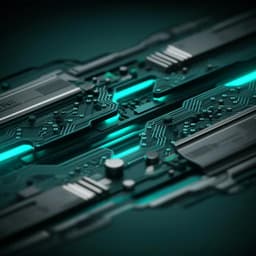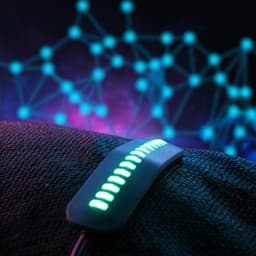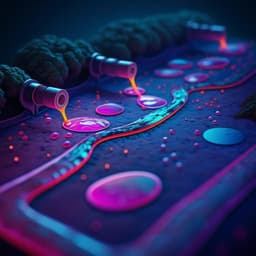
Engineering and Technology
Conformal printed electronics on flexible substrates and inflatable catheters using lathe-based aerosol jet printing
H. A. Hobbie, J. L. Doherty, et al.
Discover an innovative lathe-based aerosol jet printing method designed for creating conformal electronics on flexible, 3D surfaces. This exciting research, conducted by Hansel Alex Hobbie, James L. Doherty, Brittany N. Smith, Paolo Maccarini, and Aaron D. Franklin, showcases the fabrication of advanced electronics, including carbon nanotube transistors and a graphene sensor for critical medical monitoring applications.
~3 min • Beginner • English
Introduction
The study addresses the challenge of manufacturing conformal electronics that can be integrated directly onto nonplanar, flexible, and curvilinear substrates. Conventional fabrication relies on rigid, planar substrates and restrictive processing, limiting device geometries. Additive, direct-write (DW) printing methods, particularly aerosol jet (AJ) printing, enable non-contact, three-dimensional deposition of a wide range of materials. The research question is how to achieve uniform, high-resolution, and scalable conformal printing on curved 3D rotational bodies without the complexity and cost of 5-axis motion systems. The purpose is to develop and validate a lathe-based cylindrical-coordinate motion attachment that maintains normal print incidence around the circumference of rotational bodies, thereby improving print uniformity and enabling multilayer devices on flexible and complex substrates, including catheters and inflatable balloons. The significance lies in expanding AM for medical devices, wearables, and IoT by simplifying conformal electronics fabrication directly on target components.
Literature Review
Conformal electronics have been realized via two main routes: (1) soft-lithography with transfer/stamping, which is effective but complex, costly, and limited in scalability; and (2) direct-write (DW) printing methods (inkjet, AJ) that are inherently 3D, adaptable, and material-diverse. Inkjet has demonstrated conformal devices, but AJ printing offers advantages such as larger standoff distance (3–5 mm) and tolerance to angle and distance variations, aiding deposition on complex surfaces. However, planar AJ printing suffers when substrates have steep curvilinear features due to non-orthogonal incidence degrading film uniformity. 5-axis trunnion-based systems maintain orthogonal incidence but are complex and expensive. Prior catheter electronics often used transfer approaches, achieving only semicircular conformity and requiring multistep processing. AJ printing has been used to print resonant circuits on catheters with Cartesian systems, but required multiple steps and manual repositioning. A cylindrical-coordinate motion system with rotational control could overcome these limitations, enabling single-step, fully conformal patterns.
Methodology
System design and motion translation: A custom lathe attachment was developed for an Optomec AJ300 printer. It converts cartesian x-axis platen motion to cylindrical θ-axis rotation via a rack-and-pinion coupled to a suspended axle/mandrel, while preserving linear axial motion along y/z. The pinion mounts on a shaft with an axle clamp guided by bearings; an adjustable support aligns the rotating axle under the nozzle. Full circumferential rotation supports substrates up to 40 mm diameter. Multiple axles/mandrels can be driven by the same platen-mounted rack for scalability.
Angle of incidence: The system maintains 90° orthogonal print incidence around cylindrical surfaces by rotating the substrate (θ-axis) under a stationary nozzle, mitigating film thinning and nonuniformity seen with planar motion on curved surfaces.
Diametric ratio: The diametric ratio Ds/Dp (substrate diameter/pinion diameter) scales the translation between platen motion and substrate rotation. This affects true circumferential displacement and print speed at the substrate. Designs are adjusted by scaling x-dimensions by Ds/Dp. Pinions of 7.5, 15, 25, and 50 mm were tested with 15 and 25 mm mandrels.
Materials and inks: Graphene ink (10 wt% Sigma-Aldrich) diluted 1:2 with DI water; cellulose nanocrystals (CNC) diluted to 6 wt% in water with 0.05 wt% NaCl; semiconducting CNT ink (Nanointegris IsoSol-S100) diluted in toluene to 0.01 mg/mL; Ag nanowires (70 nm, Sigma-Aldrich) at 10 mg/mL in DI water with 0.01 wt% hydroxypropyl methylcellulose.
Substrates and pretreatment: Gloss paper (as-is), 127 µm Kapton and TPU catheter balloons (14 mm) KOH-treated (1 M, 10 min) to improve adhesion. PDMS (Sylgard 184, 10:1) used for encapsulation of catheter sensors. Silver conductive epoxy used for wire connection.
Printer and parameters: Optomec AJ300 with ultrasonic atomization, 150 µm nozzle; platen at room temperature, atomizer bath at 20 °C. Atomizer flow, sheath flow, ultrasonicator current, and print speed tuned per ink (Supplementary Table 1). Standoff distances typical for AJ maintained.
LAJ attachment fabrication and setup: Parts CAD-modeled (CST), 3D-printed in PETG (Prusa i3 MK3S+), assembled on the AJ300. Upper portion (suspended axle, alignment) mounts above platen; lower portion (rack housing/guide) mounts to platen edge. Alignment uses fiducials and camera, with ±5 µm accuracy. X-dimensions in design files scaled by diametric ratio.
Resolution and repeatability tests: Printed line arrays with center-to-center pitch 500–20 µm in circumferential (θ) and axial (z) directions at 1:1 ratio; angled patterns (±45°) 500–50 µm pitch. Overprint test of the word “Duke” three times at speeds 2–10 mm/s to assess overlay repeatability.
Device fabrication:
- Graphene resistors: Meander/arc traces printed on paper/Kapton wrapped around mandrels (15, 25 mm). Infill patterns compared (circumferential vs axial).
- All-carbon capacitors: On paper wrapped on 15 mm mandrel. Bottom graphene electrode (1.5 × 2.6 mm), CNC dielectric (single pass), graphene top electrode (0.45 × 1.88 mm). Electrical characterization with Agilent B1500.
- CNT TFTs (top-gate): On paper wrapped on 25 mm mandrel. Layer stack: graphene S/D + fiducials; CNT channel (225 µm L × 200 µm W); CNC dielectric; graphene top gate. Tested at VDS = −0.5 V, VGS sweep −1 to 1 V.
Complex geometries: Printing on concave half-cylinder (15 mm), conical PETG mandrel (15° taper) with AgNWs, and a 1000 µL pipette tip (~7.5° gradual taper) with a graphene helix. Diametric ratios chosen to minimize mismatch (typically 15 mm pinion).
Catheter sensor fabrication and testing: TPU balloon mounted on a hollow rotating axle with on-axis air feed enabling inflation during printing. A 7-turn graphene meander (1 mm trace width, 6 mm spacing) printed around the 14 mm balloon. Silver epoxy bonded copper leads, cured 1 h; PDMS drip-coating, cured at 65 °C for 1.5 h (or room temperature alternative). Resistance measured vs time (SMU), temperature measured adjacent to sensor (Type-K thermocouple + microcontroller). Temperature dependence assessed by hot-air exposure; inflation/deflation monitored by toggling pressure pump.
Characterization methods: Optical microscopy for dimensions; 3D optical/laser confocal profiler (Keyence VK-X3050) for film profiles; stylus profilometry (Dektak 150) for thickness; two-terminal and four-point-probe (Jandel) resistance/sheet resistance via SMU (Agilent B2902A). Prints (except catheter) were removed from mandrels and mounted flat for measurement.
Key Findings
- Maintaining normal incidence via LAJ mitigates nonuniformity: On a cylindrical substrate, planar AJ printing at steep obliquity (>160° incidence) produced thin/patchy graphene at position 3, whereas LAJ yielded uniform thickness across positions 1–3. Cross-sectional profiles confirmed planar traces varied in thickness while LAJ traces were consistent.
- Motion accuracy and resolution: LAJ achieved designed pitches from 500 down to 20 µm in both circumferential and axial directions at 1:1 ratio, with measured pitches closely matching targets. Simultaneous θ and z motion produced angled patterns (±45°) with accurate pitches. Multilayer overlay repeatability was demonstrated by overprinting “Duke” three times at speeds 2–10 mm/s without noticeable shift.
- Diametric ratio effects: With platen set to 2 mm/s, the true substrate print speed scales with Ds/Dp. Higher diametric ratios increased true speed, yielding thinner graphene films and higher sheet resistance; lower ratios yielded thicker films with lower sheet resistance, as expected. Design scaling by Ds/Dp produced correct 10 mm as-printed lengths across tested ratios.
- Graphene resistors on arcs: Circumferential infill produced resistance that scaled linearly with arc length. Axial infill matched circumferential infill at short arc lengths but increased at longer arcs (~11.78 mm, 90° central angle) due to more individual microstrips. Across 15 and 25 mm mandrels, resistance increased with arc length; four-point sheet resistance remained relatively consistent across lengths and diameters.
- All-carbon capacitors: Graphene/CNC/graphene capacitors (0.81 mm² overlap) showed frequency-dependent normalized capacitance decreasing nonlinearly, consistent with ionic CNC behavior. Charging/discharging currents displayed exponential profiles at 0.5, 1, and 2 V with higher leakage at 2 V.
- CNT TFTs: Fully LAJ-printed top-gate CNT TFTs on paper showed repeatable switching with ION/IOFF ~ 10² over a ±1 V gate sweep at VDS = −0.5 V. Low operating voltages stem from ionic CNC dielectric; gate leakage current exceeded 1 nA.
- Complex curvatures: LAJ printed patterns on concave surfaces (nozzle at focal point), on a 15° cone with AgNWs (non-normal incidence ~105° across cone) with acceptable uniformity at moderate obliquity, and a continuous graphene helix on a pipette tip (~7.5° taper), demonstrating tolerance to gradual multidirectional curvature.
- Catheter balloon sensor: A graphene meander printed directly on an inflated 14 mm TPU balloon functioned as a temperature and inflation sensor. Temperature response (25–80 °C) followed ΔR/R0 = −15.27 + 1.127 T − 0.0217 T² with R² = 0.987. Sensitivity (normalized %/°C) averaged −0.42 in 35–42 °C and −1.48 in 42–80 °C ranges. Inflation monitoring showed a distinct ~18% decrease in resistance upon deflation, with inflated-state drift ~1.5% during cycles 13–20 after initial conditioning (steady state reached after ~18–20 cycles).
Discussion
The LAJ approach directly addresses the central challenge of maintaining orthogonal print incidence on curved substrates, which is critical for uniform film deposition in conformal electronics. By converting cartesian motion to cylindrical rotation, the system achieves consistent trace thickness and morphology around entire circumferences without manual repositioning, unlike prior Cartesian AJ methods. Characterization shows LAJ preserves the high spatial resolution of planar AJ (down to 20 µm pitch) and offers repeatable multilayer alignment, enabling complex devices such as all-carbon capacitors and CNT TFTs on flexible, nonplanar substrates. The diametric ratio framework provides predictable control over true print speed and film thickness, guiding design compensation and enabling consistent electrical properties. Demonstrations on concave, conical, and tapered substrates confirm LAJ’s tolerance to modest obliquity, expanding applicability beyond perfect cylinders. The catheter balloon case study highlights practical medical relevance: direct on-surface printing with integrated inflation, robust encapsulation, and dual sensing functions (temperature and inflation) achieved in a single-step patterning workflow. Overall, LAJ provides a scalable, lower-complexity alternative to 5-axis systems for many conformal applications while retaining the material versatility of AJ printing.
Conclusion
This work introduces a lathe-based aerosol jet (LAJ) printing mechanism that translates cartesian motion to cylindrical-coordinate rotation, enabling high-resolution, conformal, and multilayer electronics on 3D rotational bodies up to 40 mm diameter. LAJ maintains normal print incidence, ensuring uniform films on curved surfaces, and achieves planar-comparable resolution and repeatability. The approach supports diverse materials and devices, including all-carbon capacitors and CNT TFTs, and demonstrates conformal printing on complex shapes. A practical highlight is the direct printing of a graphene meander sensor on an inflated catheter balloon for temperature and inflation monitoring with strong temperature fitting (R² = 0.987) and clear inflation-state discrimination. Future work may focus on: optimizing sensor design for higher sensitivity and lower noise in physiological ranges; reducing ionic-dielectric gate leakage; adopting water-only CNT inks for broader substrate compatibility; expanding motion capabilities (additional axes) for fully multidirectional curvatures; and scaling the modular system for parallel, multi-mandrel manufacturing.
Limitations
- Geometric limitations: The single-axis rotational system excels on cylindrical and modestly tapered geometries but cannot maintain perfect orthogonality on multidirectional curvatures (e.g., spherical, complex nonuniform surfaces); oblique incidence reduces film thickness and definition at large tapers.
- Size constraint: Current setup supports substrates up to 40 mm diameter under the nozzle.
- Material/process constraints: CNT ink in toluene may be incompatible with some substrates; ionic CNC dielectrics introduce notable gate leakage (>1 nA). Initial conditioning cycles cause resistance drift in balloon-mounted graphene sensors before steady state.
- Design sensitivity to diametric ratio: True print speed and film thickness depend on Ds/Dp, requiring careful design scaling and parameter tuning.
- Measurement/contact artifacts: Early catheter sensor measurements exhibited noise due to simple contact methods; improved contact schemes are needed for lower-noise performance.
Related Publications
Explore these studies to deepen your understanding of the subject.







